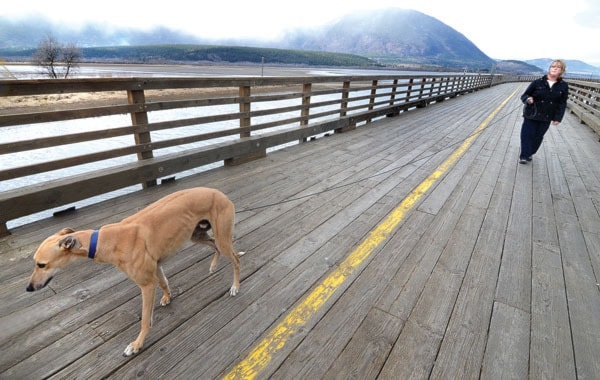Racing greyhounds are fast. They can reach a speed of 45 mph within three strides. They are a thing of beauty to watch running. They are also brave, devoted, intelligent, laid-back, charming and loving. It is easy to understand the special bond that can develop between a greyhound owner and their dogs – especially owners of retired racing greyhounds.
It has only been six weeks since Stephanie Roop and her family adopted Beau, a four-year-old, red fawn, retired racing greyhound through Chinook Winds Greyhound Rescue in Calgary. Since then, Roop and Beau have established a strong relationship.
“Sometimes he does some pretty quirky things that I’ve never seen another dog do,” she says, “but they’re things that are so endearing, things that you can’t help love him for. When we come home, he does this little dance – he’s so excited to see us. These dogs haven’t known love before. He’s quite fascinated by all the love and attention that he gets. When I first took him for a walk, he would lean against me. He was so insecure. But he’s come a long way in a short period of time.”
In 1993, Hinsdale Greyhound Park, in Hinsdale, N.H., started the first adoption program for retired racing greyhounds. There are now programs, adoption agencies and rescue societies all over the world that place retired racers in loving homes.
For any one who is interested in adopting a retired racing greyhound, there are a few things they should be aware of before making the decision to invite one into their hearts and their home.
Whether you agree with greyhound racing or not, the sport still exists. It began back in the 1920s and peaked around the 1970s. Unfortunately, in almost all instances, the dogs involved did not have a happy retirement after their racing careers were over. In the late 1970s it was estimated that 20,000 dogs, or more, a year were being destroyed after fulfilling their purpose on the track. Those numbers raised concern among dog-lovers and a number of rescue groups and adoption agencies were formed to place retiring dogs in homes rather than simply see them being destroyed. Since then the number of dogs killed has been drastically reduced.
Greyhounds are incredibly special animals; even their blood chemistry is different from other dogs. Their lack of body fat, long, thin bones, fragile skin, and sensitive souls means they need to be protected from the extremes of temperature, rough environments, and inappropriate handling. Greyhounds, especially adopted retired racing dogs, are very sensitive to the tone of their owner’s voice. They can also be strong minded and sometimes will not listen if they are stronger willed than their owner. On the other hand, they do not respond well to harsh discipline.
As a rule, greyhounds are gentle and even-tempered. They are normally good with children, although they do not usually like rough play and might not be the right choice for families with young children. They also have a definite prey drive. It is in their very instinct to chase anything that moves quickly. Outside, greyhounds have tremendous stamina. It is important to remember that racing dogs are bred for performance. They love to run and require wide open spaces. They can however, become distracted and, when off leash, may head off after something they see as prey.
Indoors, greyhounds are calm and sociable to a point where they might even be considered lazy. They are sometimes affectionately known as “45 mph Couch Potatoes.” Those considering adopting a retired greyhound should be aware of these factors, although generally they seldom present difficulties.
Greyhounds do require a gentle but firm approach – but a greyhound that knows its place in the pack and what is expected of it, is a happy greyhound. So too, are those people who have been willing to let them into their hearts and homes.
